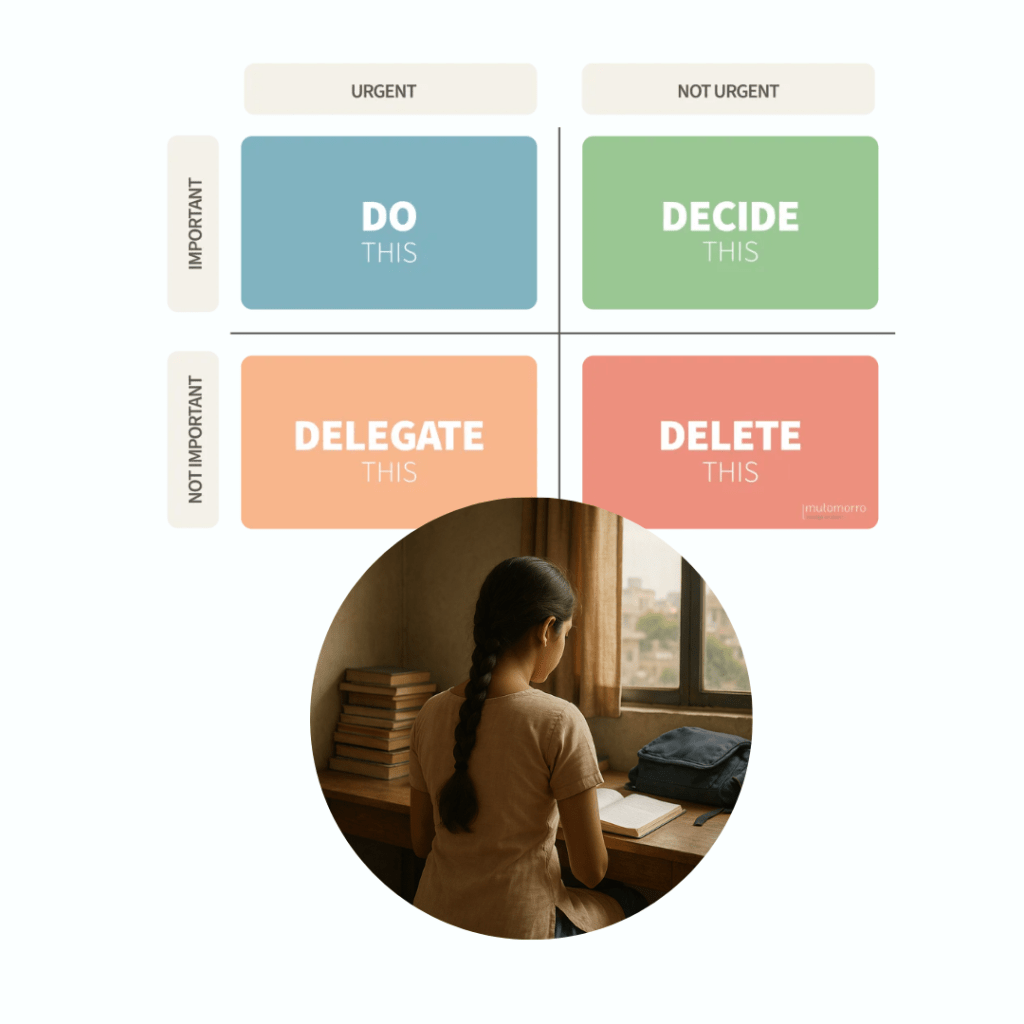In the heart of Delhi, 16-year-old Manyata (Name Changed on Request of the respondent) juggled the whirlwind of school life, family expectations, and friendships. Her days started before sunrise, with the sound of her alarm blending into the distant honking of autos outside her window. She hurried through breakfast, caught the school bus, and spent hours in classrooms, her mind darting between equations, essays, and the next big test.
By the time she returned home, her bag felt heavier with assignments, and her phone buzzed with reminders: “Maths homework due tomorrow,” “Best friend’s birthday gift,” “Help mom with Diwali cleaning,” and “Practice for debate finals.” Everything seemed important, and everything seemed urgent. Manyata often found herself paralyzed, not knowing what to do first.
One evening, as the city lights flickered on and the aroma of street food drifted through her window, Manyata sat at her desk, staring at her endless to-do list. Her older cousin Priya, visiting from college, peeked in and saw the worry on Manyata’s face.
Priya sat beside her and listened as Manyata poured out her frustrations. “It feels like I’m always running, but never catching up,” she confessed.
Priya smiled, “You know, sometimes it helps to just step back and look at things differently. Not everything needs to be done right now. Some things can wait, some things you can ask for help with, and some things… maybe you don’t need to do at all.”
They talked about what really mattered to Manyata—her upcoming exams, her dream to win the debate, and her desire to make her mom proud. Together, they made a simple list, putting the most important things at the top and letting the less urgent ones fall lower. That night, Manyata felt lighter. She finished her maths homework, set aside time to practice her debate speech, and even helped her mom with the decorations. The next day, she walked into school with a smile, ready to face whatever came her way.
As Manyata began to feel more in control of her daily routine, Priya introduced her to a powerful tool called the Eisenhower Matrix. This simple framework, made up of four squares, helps people sort their tasks based on two questions: Is it urgent? Is it important? By using the matrix, Manyata could quickly see which assignments and responsibilities needed her immediate attention, which ones she could plan for later, what she might delegate, and which distractions she could simply let go.
For example, finishing her science project and revising for an upcoming test would go into the “urgent and important” box—these she would do first. Preparing for the essay competition or practicing guitar, which were important but not urgent, she could schedule for later. Replying to group chats or helping with minor chores could be delegated or done after her main work. Scrolling endlessly on social media, which was neither urgent nor important, could be cut out altogether.
With the Eisenhower Matrix, Manyata found her days easier to manage. She no longer felt pulled in every direction. Instead, she focused on what truly mattered, reduced her stress, and made steady progress toward her goals—turning her busy Delhi life into one of clarity and calm.
Using the Eisenhower Matrix for a Student Study Plan
The Eisenhower Matrix is a practical tool for students to organize their study schedules and manage academic responsibilities efficiently. By dividing tasks into four categories—urgent and important, important but not urgent, urgent but not important, and neither urgent nor important—students can prioritize their workload and reduce stress.
How to Apply the Matrix:
- Urgent and Important: These are tasks that require immediate attention and have a significant impact on academic performance. For example, completing an assignment due tomorrow, preparing for a test the next day, or submitting a project by the deadline. These should be tackled first in the study plan.
- Important but Not Urgent: These are tasks that contribute to long-term academic goals but do not have an immediate deadline. Examples include regular revision of subjects, preparing for upcoming entrance exams like CUET UG, or working on skill development such as improving quantitative aptitude or general knowledge1. Schedule these tasks into your weekly or monthly study plan to ensure consistent progress.
- Urgent but Not Important: These tasks demand attention quickly but do not significantly affect academic success. Examples might include responding to routine messages from classmates or attending meetings that are not directly related to studies. Delegate these tasks if possible, or handle them after completing more critical work.
- Neither Urgent nor Important: These are distractions or low-value activities, such as excessive social media use or watching unrelated videos. These should be minimized or eliminated from the study plan to maintain focus on academic priorities.
Benefits for Students:
- Helps identify what needs immediate attention versus what can be planned ahead.
- Reduces last-minute stress by encouraging early preparation for exams and assignments.
- Frees up time by cutting down on unimportant activities.
- Encourages a balanced approach to both urgent tasks and long-term academic growth.
By consistently applying the Eisenhower Matrix, students can create a structured and effective study plan, ensuring that both immediate deadlines and future goals are managed efficiently



